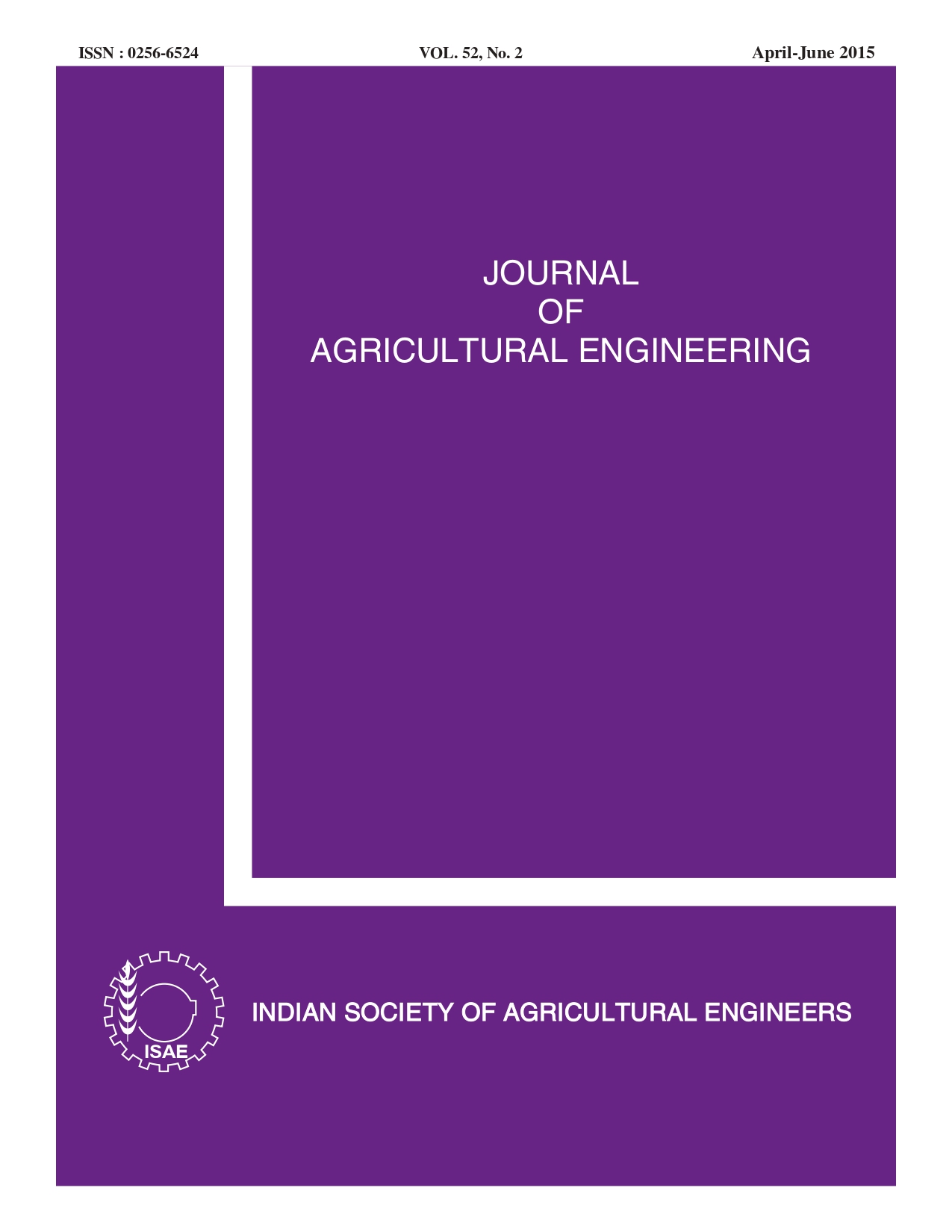Effect of Microwave Treatment on Dehulling of Pigeon Pea
DOI:
https://doi.org/10.52151/jae2015522.1574Keywords:
Microwave pre-treatment, response surface methodology, dehulling, pigeon peaAbstract
Dehulling of pulses is an energy intensive operation, also associated with significant product losses. In the present study, microwave energy was examined as an alternative pre-milling treatment for pigeon pea. Response surface methodology (RSM) based central composite design was used to study the effect of the independent variables (microwave power and exposure time) on the dehulling parameters. The process parameters showed significant effects on various dehulling parameters (per cent dehulled whole and splits, un-dehulled whole and splits, fines/ broken, powder and hulls). Highest dehulling efficiency and lowest loss were observed for a microwave treatment at 630 W for 90 s. With the rising market demand for pulses, microwave energy can prove to be a profitable pretreatment technique for dehulling of pigeon pea.
References
Amarteifio J O; Munthali D C; Karikari S K; Morake T K. 2002. The composition of pigeon peas (Cajanus cajan L.) grown in Botswana. Plant Foods Hum. Nutr., 57(2), 173-177.
Burridge P; Hensing A; Petterson D. 2001. Australian pulse quality laboratory manual. SARDI Grain Laboratory for GRDC, Urrabrae.
Ehiwe A O F; Reichert R D. 1987. Variability in dehulling quality of cowpea, pigeon pea, and mung bean cultivars determined with the tangential abrasive dehulling device. Cereal Chem., 64(2), 86-90.
FAO. 1983. Report of the composite flour mission to Nigeria. FAO, Rome, pp: 43.
Goyal R K; Vishwakarma R K; Wanjari O D. 2009. Optimization of process parameters and mathematical modelling for dehulling of pigeonpea. Int. J. Food Sci. Technol., 44(1), 36-41.
Jeong I J; Kim K J. 2009. An interactive desirability function method to multiresponse optimization. Eur. J. Oper. Res., 195(2), 412-426.
Joyner J J; Yadav B K. 2013. Microwave assisted dehulling of black gram (Vigna mungo L). J. Food Sci. Tech., 52(4), 1-10.
Mangaraj S. 2011. Milling study of multiple pulses using CIAE dhal mill for optimal responses. J. Food Proc. Technol., 2(2), 1-8.
Mangaraj S; Singh K P. 2011. Optimization of machine parameters for milling of pigeon pea using RSM. Food Bioprocess Technol., 4(5), 762-769.
Negi A; Boora P; Khetarpaul N. 2001. Effect of microwave cooking on the starch and protein digestibility of some newly released moth bean (Phaseolus aconitifolius Jacq.) cultivars. J. Food Comp. Anal., 14(5), 541-546.
Oomah B D; Mazza G. 1998. Fractionation of flaxseed with a batch dehuller. Indus. Crops Prod., 9(1), 19-27.
Opoku A; Tabil L; Meda V. 2009. Effect of microwave drying and storage on the color, breakage, dehulling and cooking quality of two red lentil varieties. Annual Conference of Canadian Society for Bioengineering, Rodd’s Brudenell River Resort, PEI, 12-17 July (CSBE09-304).
Oomah B D; Kotzeva L; Allen M; Bassinello P Z. 2014. Microwave and micronization treatments affect dehulling characteristics and bioactive contents of dry beans (Phaseolus vulgaris L.). J Sci. Food Agric., 94(7), 1349-1358.
Phirke P S; Bhole N G. 1999. The effect of pre-treatment on the strength and dehulling properties of pigeonpea grain. Int. J. Food Sci. Technol., 34(2), 107-113.
Phirke P S; Bhole N G. 2000. Pretreatment of pigeonpea grain for improvement of dehulling characteristics. Int. J. Food Sci. Technol., 35(3), 305-313.
Purohit P; Jayas D S; Chelladurai V; Yadav B K. 2013. Microwave treatment of mung bean (Vigna radiata) for reducing the cooking time. Appl. Eng. Agric., 29(4), 547-556.
Ramakrishnaiah N; Kurien P P. 1985. Non-starchy polysaccharides of pigeon pea and their influence on dehulling characteristics. J. Food Sci. Technol., 22(6), 429-430.
Ross K A; Alejo-Lucas D; Malcolmson L; Arntfield S D. 2010. Effect of milling treatments and storage conditions on the dehulling characteristics of red lentils. Int. J. Postharvest Technol. Innov., 2(1), 89-113.
Salunkhe D K; Chavan J K; Kadam S S; Reddy N R. 1986. Pigeonpea as an important food source. Crit. Rev. Food Sci. Nutr., 23(2), 103-145.
Saxena K B; Kumar R V; Sultana R. 2010. Quality nutrition through pigeonpea—a review. Health, 2(11), 1335-1344.
Schirack A V; Sanders T H; Sandeep K P. 2007. Effect of processing parameters on the temperature and moisture content of microwave-blanched peanuts. J. Food Proc.Eng., 30(2), 225-240.
Tiwari B K; Mohan R J; Vasan B S. 2007. Effect of heat processing on milling of black gram and its end product quality. J. Food Eng., 78(1), 356-360.
Tiwari B K; Tiwari U; Mohan R J; Alagusundaram K. 2008. Effect of various pre-treatments on functional, physiochemical, and cooking properties of pigeon pea (Cajanus cajan L). Food Sci. Technol. Int., 14(6), 487-495.
Tiwari B K; Jaganmohan R; Venkatachalapathy N; Tito Anand M; Surabi A; Alagusundaram K. 2010. Optimisation of hydrothermal treatment for dehulling pigeon pea. Food Res. Int., 43(2), 496-500.
Tiwari B K; Gowen A; McKenna B. 2011. Pulse Foods: Processing, Quality and Nutraceutical Applications.Academic Press, Amsterdam, The Netherlands, pp: 3.
Tran V N; Cavanagh A K. 1980. Taxonomic implications of fracture load and deformation histograms and the effects of treatments on the impermeable seed coat of Acacia species. Aust. J. Bot., 28(1), 39-51.
Walde S G; Balaswamy K; Velu V; Rao D G. 2002. Microwave drying and grinding characteristics of wheat (Triticum aestivum). J. Food Eng., 55(3), 271-276.
Wang N. 2005. Optimization of a Laboratory Dehulling Process for Lentil (Lens culinaris). Cereal Chem., 82(6),671-676.














